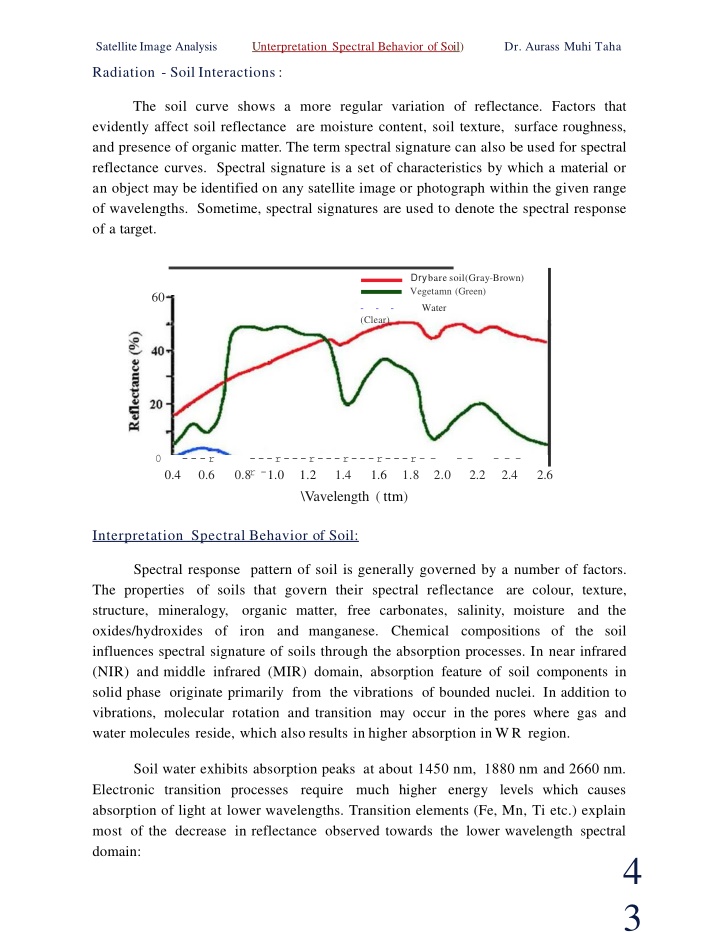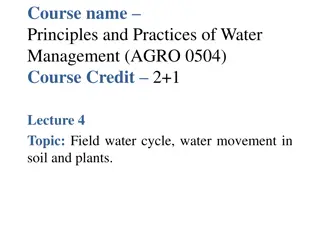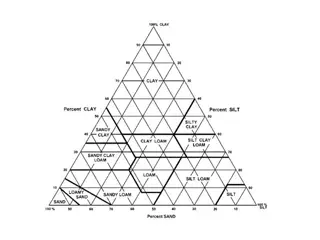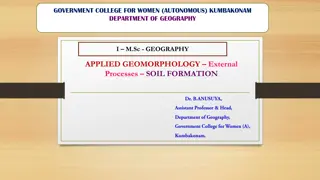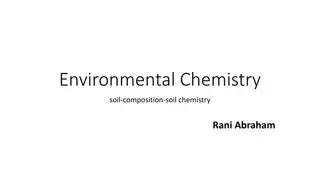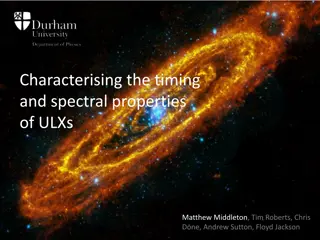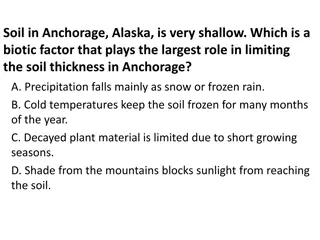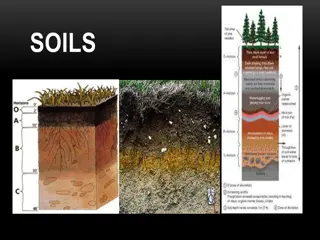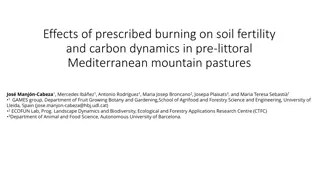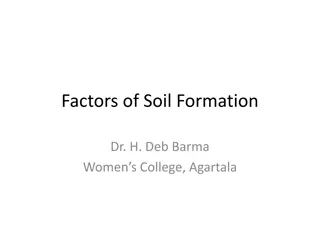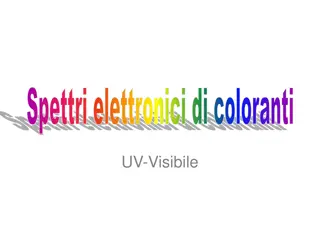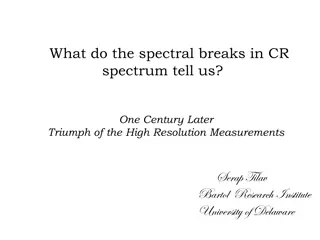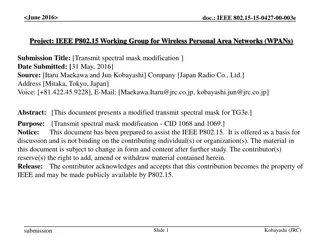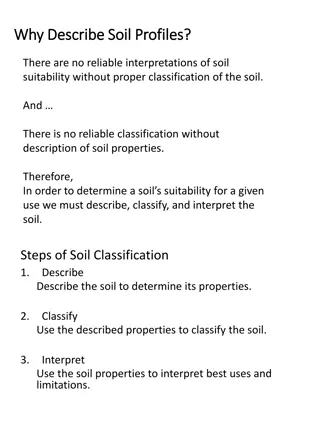Spectral Behavior of Soil: Factors Affecting Soil Reflectance
The spectral behavior of soil is influenced by various factors like moisture content, texture, organic matter, and mineralogy. Soil reflectance patterns, absorption processes, and spectral signatures play a crucial role in identifying soil properties on satellite images.
Download Presentation

Please find below an Image/Link to download the presentation.
The content on the website is provided AS IS for your information and personal use only. It may not be sold, licensed, or shared on other websites without obtaining consent from the author.If you encounter any issues during the download, it is possible that the publisher has removed the file from their server.
You are allowed to download the files provided on this website for personal or commercial use, subject to the condition that they are used lawfully. All files are the property of their respective owners.
The content on the website is provided AS IS for your information and personal use only. It may not be sold, licensed, or shared on other websites without obtaining consent from the author.
E N D
Presentation Transcript
SatelliteImage Analysis Unterpretation Spectral Behavior of Soil) Dr. Aurass Muhi Taha Radiation - Soil Interactions : The soil curve shows a more regular variation of reflectance. Factors that evidently affect soil reflectance are moisture content, soil texture, surface roughness, and presence of organic matter. The term spectral signature can also be used for spectral reflectance curves. Spectral signature is a set of characteristics by which a material or an object may be identified on any satellite image or photograph within the given range of wavelengths. Sometime, spectral signatures are used to denote the spectral response of a target. Drybare soil(Gray-Brown) Vegetamn (Green) 60 - (Clear) - - Water 0 ---r ---r---r---r---r---r- - r - - - - - - 0.4 0.6 0.8 1.0 1.2 \Vavelength ( ttm) 1.4 1.6 1.8 2.0 2.2 2.4 2.6 Interpretation Spectral Behavior of Soil: Spectral response pattern of soil is generally governed by a number of factors. The properties of soils that govern their spectral reflectance are colour, texture, structure, mineralogy, organic matter, free carbonates, salinity, moisture and the oxides/hydroxides of iron and manganese. Chemical compositions of the soil influences spectral signature of soils through the absorption processes. In near infrared (NIR) and middle infrared (MIR) domain, absorption feature of soil components in solid phase originate primarily from the vibrations of bounded nuclei. In addition to vibrations, molecular rotation and transition may occur in the pores where gas and water molecules reside, which also results in higher absorption in WR region. Soil water exhibits absorption peaks at about 1450 nm, 1880 nm and 2660 nm. Electronic transition processes require much higher energy levels which causes absorption of light at lower wavelengths. Transition elements (Fe, Mn, Ti etc.) explain most of the decrease in reflectance observed towards the lower wavelength spectral domain: 4 3
Satellite Image Analysis a nterpretation Spectral Behavior of Soil) Dr. Aurass Muhi Taha Notreatment Iron removed Oraanle matter removed - 8 c i c: 70 60 50 40 30 lO 10 2. 1.0 2.5 2.0 0.5 Wavelength m Organic matter absorbs strongly in shorter wavelength as well as in the infrared region due to the presence of various functional groups and conjugate bonds the reflectance spectra of evaporate minerals, which have diagnostic spectra due to vibration of Hand NO bonds. Only the anhydrous CP and S04 2salts do not contain any diagnostic features and cannot be distinguished from each other. Large grain size samples exhibit numerous well developed absorption features at wavelengths less than 1600 nm and smaller grains exhibit fewer less developed features in this region and well developed features at wave lengths more than> 1600nm. Absorption features that appear in the spectra of minerals and rocks are due to either electronic or vibration processes. However, it is vibration process that is important in evaporate minerals. Vibration absorption features are caused by excitation of bonds between anion groups. Many of the spectral features in the minerals studied here can be explained by vibration absorption due to water molecules in or on these minerals. Other features are caused by vibration of carbonate (C03 2, nitrate (N03 1 and ammonium (NH4+1bonds. The spectral response of water illustrates many of the ) properties of vibration features. For a molecule of n particles there are 3n-6 fundamental vibrations. As water has three particles it has three fundamental vibrational modes that occur at wavelengths longer than 2500 nm. ) ) The exact frequency of these fundamental adsorptions depends on the strength of the hydrogen bonds and thus varies according to whether the water is gas, solid or liquid. Absorption features at shorter wavelengths than these fundamentals arise from linear combinations and overtones of these fundamental adsorptions. These are seen in the 400 to 2500 nm region. Water molecules in minerals may occur in five different ways: 4 4
SatelliteImage Analysis Unterpretation Spectral Behavior of Soil) Dr. Aurass Muhi Taha a) As water molecules physically absorbed to the surface of mineral grains; b) As water in fluid inclusions; c) As water in ill-defined sites in the crystal structure; d) As water in channels in the crystals that are not essential to the crystal structure (zeolitic water); and e) As water that forms an essential part of the crystal lattice. "a J " 1 : 1 j a "a = a - I = e - e - = - 1.1 i. "1:- .J t!J .. e - 60 50 10 1.5 1.0 Wavelength (f.lm)2.0 2.5 Water occurring in the first three ways is largely unrelated to mineralogy and its absorption feature near 1400 and 1900 nm is indicative of this. Many of the anhydrous salts investigated exhibit these absorption features as they have hydroscopic properties. \ ater occurring in the last two ways produces numerous features arising from overtones and combinations of fundamental absorptions long ward of 2500 nm. Spectra acquired from different specimens of the same mineral exhibit variations due to changes in grain size, shape and structural order. For example, aragonite and calcite have features due to the vibration of C-0 bonds, although they are chemically identical the absorption features have slightly different positions. As some of the minerals examined in this study have numerous crystal forms (e.g., gypsum) the positions of their absorption features can be expected to vary slightly. Apart from the absorption processes, dielectric discontinuities encountered in the soil background media cause scattering. Other sources of variations in soil optical properties are linked to the porosity and both microscopic and macroscopic surface roughness. The presence of -OH group and HzO molecule in soil minerals is also responsible for low reflectance of soils. 45
SatelliteImage Analysis Unterpretation Spectral Behavior of Soil) Dr. Aurass Muhi Taha Soil texture refers to relative proportion of sand, silt & clay and affects the spectral reflectance of the soils due to its influence on water holding capacity and the size of soil particles. I: BacilliSaad l: S.IJneSoil 3: Rh'er Sa d 4:SUIlowRedSoli 5:Mcdi m RedSoil 6: Red Saady Soil 7: DeepRedSoli 8:Crops 9: HUiy aru 10: Medlu BlaekSoU 11: DeepBlafk Soli 12:Shallow Water 13:DeepWater 160 140 - - QI 80 c= J40 f1) llO Go)100 60 lO O.S.0.6 m 0.6-0.7 m 0.7-I.B m 0.8-l.IJ.UD Wavelength J.l Finer the particles size, the soil surface becomes smoother and more incoming solar energy is reflected. An increase in particle size causes a decrease in reflectance. However, silt content of soil is considered as major controlling factor for spectral reflectance. The reflectance becomes lower as the silt content decreases. However, it is commonly observed that sandy soil exhibits higher reflectance than that of clayey soil, which is due to abundance of macro pores and air-soil interface that cause multiple reflection/scattering. Soil erosion, an important soil degradation process can influence soil spectra. Soil erosion influences indirectly by influencing soil surface roughness and iron content intop soils. Sothe more isthe erosion the more will be soil reflectance in the longer wave length of visible andNIR region. 46
